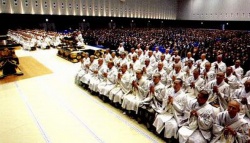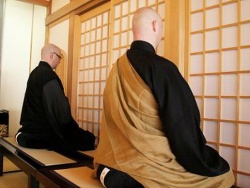Difference between revisions of "The sangha in the year 2003"
| Line 7: | Line 7: | ||
In today's [[world]], it is difficult to find a true [[BUDDHA]]. Although [[Sakyamuni Buddha]], in his [[nirmanakaya]] [[form]], entered [[paranirvana]] in 487 B.C. (the year 2013 will be 2500 years after), the [[sambhogakaya]] and [[dharmakaya]] [[forms]] are everpresent, but these [[forms]] are hidden from our ordinary [[eyes]], and not easy to discover. Occasionaly other [[emanations]] of the [[nirmanakaya]] [[Buddha]] appear in the [[world]], but rarely, and even then seen only by a few [[people]]. | In today's [[world]], it is difficult to find a true [[BUDDHA]]. Although [[Sakyamuni Buddha]], in his [[nirmanakaya]] [[form]], entered [[paranirvana]] in 487 B.C. (the year 2013 will be 2500 years after), the [[sambhogakaya]] and [[dharmakaya]] [[forms]] are everpresent, but these [[forms]] are hidden from our ordinary [[eyes]], and not easy to discover. Occasionaly other [[emanations]] of the [[nirmanakaya]] [[Buddha]] appear in the [[world]], but rarely, and even then seen only by a few [[people]]. | ||
| − | Likewise, the true [[DHARMA]] is difficult to find nowadays. In the [[time]] [[Sakyamuni]] was roaming the {{Wiki|Ganges valley}}, his followers held different opinions, right and wrong, on what constituted the [[Dharma]], and [[Sakyamuni]] would hear these versions and either praise or correct them, sometimes by speaking, sometimes by remaining [[silent]]. In the centuries after his [[parinirvana]], opinions diverged to the point of near-irrconcilability as the [[Dharma]] continually grew and evolved into a myriad of [[lineages]], sects, schools of [[thought]], and practices. Some [[people]] question whether the genuine [[Dharma]] [[exists]] at all 2500 years later. Furthermore, the words of [[Sakyamuni]] as written down have subtly shifted their meanings over [[time]], along with being translated into a varity of cultures and [[languages]]. In any case, the true [[Dharma]] is definitely difficult to find, and not apparent on its face. | + | Likewise, the true [[DHARMA]] is difficult to find nowadays. In the [[time]] [[Sakyamuni]] was roaming the {{Wiki|Ganges valley}}, his followers held different opinions, right and wrong, on what constituted the [[Dharma]], and [[Sakyamuni]] would hear these versions and either praise or correct them, sometimes by {{Wiki|speaking}}, sometimes by remaining [[silent]]. In the centuries after his [[parinirvana]], opinions diverged to the point of near-irrconcilability as the [[Dharma]] continually grew and evolved into a {{Wiki|myriad}} of [[lineages]], sects, schools of [[thought]], and practices. Some [[people]] question whether the genuine [[Dharma]] [[exists]] at all 2500 years later. Furthermore, the words of [[Sakyamuni]] as written down have subtly shifted their meanings over [[time]], along with being translated into a varity of cultures and [[languages]]. In any case, the true [[Dharma]] is definitely difficult to find, and not apparent on its face. |
| − | However, the true [[SANGHA]] is not difficult to find. [[Sakyamuni]] [[Buddha's]] [[sangha]] consisted of [[monks]], [[nuns]], [[laywomen]], and [[laymen]]. Whether it is possible or not to practice as a [[monk]] or [[nun]], a [[sangha]] of [[laywomen]] or [[laymen]] certainly [[exists]] and flourishes. Without a [[doubt]] vast numbers of [[people]] have taken the Triple [[Refuge]], scrupulously keep the 5 basic [[precepts]]d undertake practices to the point where they regularly enter [[samadhi]], therein meeting face-to-face with the [[Sambhogakaya]] [[Buddhas]] and [[realizing]] various facets of the [[infinite]] [[Dharma]]. | + | However, the true [[SANGHA]] is not difficult to find. [[Sakyamuni]] [[Buddha's]] [[sangha]] consisted of [[monks]], [[nuns]], [[laywomen]], and [[laymen]]. Whether it is possible or not to [[practice]] as a [[monk]] or [[nun]], a [[sangha]] of [[laywomen]] or [[laymen]] certainly [[exists]] and flourishes. Without a [[doubt]] vast numbers of [[people]] have taken the Triple [[Refuge]], scrupulously keep the 5 basic [[precepts]]d undertake practices to the point where they regularly enter [[samadhi]], therein meeting face-to-face with the [[Sambhogakaya]] [[Buddhas]] and [[realizing]] various facets of the [[infinite]] [[Dharma]]. |
| − | The person-to-person transmissions of the [[Buddha's teachings]] have come down to us today as countless [[lineages]] and sects, some true and some false, but with enough true and genuine [[lineages]] that we can easily and confidently [[take refuge]] in the [[Sangha]]. And after [[taking refuge]], if one studies and practices diligently and sincerely, and maintains at least the layman's five-fold [[morality]], then inevitably with [[time]] the shining [[Buddha]] and the wonderful [[Dharma]] will both appear and become reliable [[refuges]], combining into the Triple [[Refuge]] as we trod the [[happy]] [[path]], opening out onto the field of [[Bodhisattvas]]. The [[Gandhavyuha Sutra]] contains the following beautiful summary of the family of the [[Bodhisattva]] in the words of [[Maitreya]]: | + | The person-to-person [[transmissions]] of the [[Buddha's teachings]] have come down to us today as countless [[lineages]] and sects, some true and some false, but with enough true and genuine [[lineages]] that we can easily and confidently [[take refuge]] in the [[Sangha]]. And after [[taking refuge]], if one studies and practices diligently and sincerely, and maintains at least the layman's five-fold [[morality]], then inevitably with [[time]] the shining [[Buddha]] and the wonderful [[Dharma]] will both appear and become reliable [[refuges]], combining into the Triple [[Refuge]] as we trod the [[happy]] [[path]], opening out onto the field of [[Bodhisattvas]]. The [[Gandhavyuha Sutra]] contains the following beautiful summary of the family of the [[Bodhisattva]] in the words of [[Maitreya]]: |
[[Transcendent wisdom]] is the mother of | [[Transcendent wisdom]] is the mother of | ||
| Line 17: | Line 17: | ||
all other [[Bodhisattvas]] are their brothers | all other [[Bodhisattvas]] are their brothers | ||
and sisters, the [[determination]] for [[enlightenment]] | and sisters, the [[determination]] for [[enlightenment]] | ||
| − | is their family, and practice is the rule | + | is their family, and [[practice]] is the {{Wiki|rule}} |
of their family. | of their family. | ||
</poem> | </poem> | ||
Latest revision as of 20:30, 8 March 2015
I TAKE REFUGE IN THE BUDDHA
I TAKE REFUGE IN THE DHARMA
I TAKE REFUGE IN THE SANGHA
In today's world, it is difficult to find a true BUDDHA. Although Sakyamuni Buddha, in his nirmanakaya form, entered paranirvana in 487 B.C. (the year 2013 will be 2500 years after), the sambhogakaya and dharmakaya forms are everpresent, but these forms are hidden from our ordinary eyes, and not easy to discover. Occasionaly other emanations of the nirmanakaya Buddha appear in the world, but rarely, and even then seen only by a few people.
Likewise, the true DHARMA is difficult to find nowadays. In the time Sakyamuni was roaming the Ganges valley, his followers held different opinions, right and wrong, on what constituted the Dharma, and Sakyamuni would hear these versions and either praise or correct them, sometimes by speaking, sometimes by remaining silent. In the centuries after his parinirvana, opinions diverged to the point of near-irrconcilability as the Dharma continually grew and evolved into a myriad of lineages, sects, schools of thought, and practices. Some people question whether the genuine Dharma exists at all 2500 years later. Furthermore, the words of Sakyamuni as written down have subtly shifted their meanings over time, along with being translated into a varity of cultures and languages. In any case, the true Dharma is definitely difficult to find, and not apparent on its face.
However, the true SANGHA is not difficult to find. Sakyamuni Buddha's sangha consisted of monks, nuns, laywomen, and laymen. Whether it is possible or not to practice as a monk or nun, a sangha of laywomen or laymen certainly exists and flourishes. Without a doubt vast numbers of people have taken the Triple Refuge, scrupulously keep the 5 basic preceptsd undertake practices to the point where they regularly enter samadhi, therein meeting face-to-face with the Sambhogakaya Buddhas and realizing various facets of the infinite Dharma.
The person-to-person transmissions of the Buddha's teachings have come down to us today as countless lineages and sects, some true and some false, but with enough true and genuine lineages that we can easily and confidently take refuge in the Sangha. And after taking refuge, if one studies and practices diligently and sincerely, and maintains at least the layman's five-fold morality, then inevitably with time the shining Buddha and the wonderful Dharma will both appear and become reliable refuges, combining into the Triple Refuge as we trod the happy path, opening out onto the field of Bodhisattvas. The Gandhavyuha Sutra contains the following beautiful summary of the family of the Bodhisattva in the words of Maitreya:
Transcendent wisdom is the mother of
Bodhisattvas, skillful means is their father,
all other Bodhisattvas are their brothers
and sisters, the determination for enlightenment
is their family, and practice is the rule
of their family.

